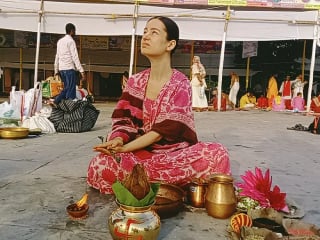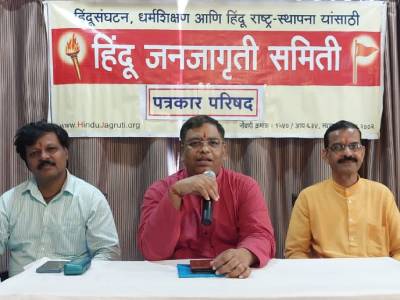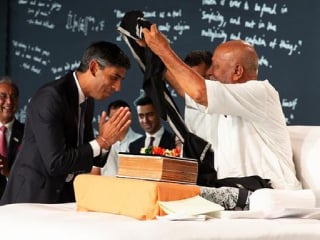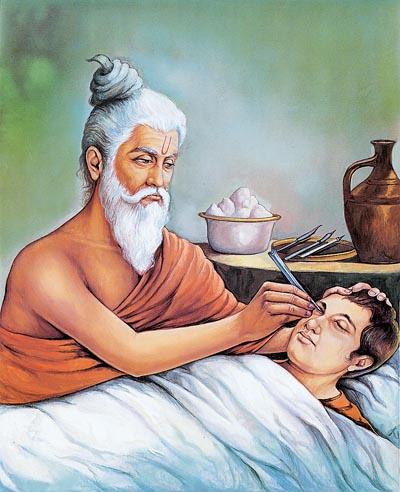 Sushruta – Father of Cosmetic Surgery
Sushruta – Father of Cosmetic Surgery
From 1769 AD to 1799 AD, in a period of thirty years, four Mysore Wars were fought between Hyder Ali and his son Tipu Sultan and the British. As a result of these wars, the British learnt two very important Indian techniques — rocketry and plastic surgery. Both these Indian techniques were further improved first in England and then in other European countries (see ‘Story of Indian Rockets’, DREAM, October 1999).
How the British learnt the art of Indian plastic surgery is a fascinating story.
A Maratha cart-driver, Kawasajee, who had served the British, and four tilanges (Indian soldiers of British army) had fallen into the hands of the Sultan of Srirangapattam. Their noses and right arms were cut off as a punishment for serving the enemy. Then they were sent back to the English command.
After some days, when dealing with an Indian merchant, the English commanding officer noticed that he had a peculiar nose and scar on his forehead. On inquiry, he learnt that the merchant’s nose had been cut off as a punishment for adultery and that he had a substitute nose made by a Maratha Vaidya of the kumhar (potter) caste. The commanding officer sent for the Vaidya and asked him to reconstruct the nose of Kawasajee and others.
The operation was performed near Pune in the presence of two English doctors, Thomas Cruso and James Findlay. An illustrated account of this operation, carried out by an unnamed Vaidya, appeared in the Madras Gazette. Subsequently, the article was reproduced in the Gentleman’s Magazine of London in October 1794.
The operation is described as follows :
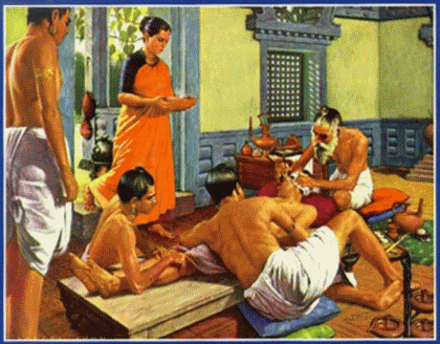
“A thin plate of wax is fitted to the stump of the nose so as to make a nose of good appearance; it is then flattened and laid on the forehead. A line is drawn around the wax, which is then of no further use, and the operator then dissects off as much skin as it had covered, living undivided a small slip between the eyes. This slip preserves the blood circulation till a union has taken place between the new and the old parts.
“The cicatrix of the stump of the nose is next paired off, and immediately behind the new part, an incision is made through the skin which passes around both alae, and goes along the upper lip. The skin, now brought down from the forehead and being twisted half around, is inserted into this incision, so that a nose is formed with a double hold above and with its alae and septum below fixed in the incision. A little Terra Japonica (pale-catechu) is softened with water and being spread on slips of cloth, five or six of these are placed over each other to secure the joining. No other dressing but this cement is used for four days. It is then removed, and cloths dipped in ghee are applied. The connecting slip of skin is divided about the twentieth day, when a little more dissection is necessary to improve the appearance of the new nose. For five or six days after the operation, the patient is made to lie on his back, and on the tenth day, bits of soft cloth are put into the nostrils to keep them sufficiently open. This operation is always successful. The artificial nose is secured and looks nearly as well as the natural nose, nor is the scar on the forehead very observable after a length of time.”
This description fired the imagination of the young English surgeon J.C. Carpue, who after gathering more information on the “Indian nose” performed two similar operations in 1814 with successful results. After Carpue published his account, Graefe, a German surgeon, performed similar plastic operations of the nose using skin from the arm. After this, plastic surgery became popular throughout Europe. All replacement operations which use a flap of skin in the immediate vicinity of the loss are known as Indian plastic surgery.
Plastic surgery has little to do with plastics, the synthetic substances so common today. The term ‘plastic’, derived from the Greek plastikos, means to mould or shape. The task of plastic surgery is to restore the appearance and function of parts of the body destroyed or damaged by disease or injury. Contrary to popular belief, plastic or reconstructive surgery is not merely cosmetic surgery but an important discipline that aims at correcting all sorts of physical deformities. Though a very old technique, plastic surgery has made great strides only after the First World War.
The Bible contains no reference of plastic operations. There is no mention of plastic surgery in the ancient Greek literature. Homer (9th century BC) has described various types of wounds and their treatments but did not mention the possibility of replacing parts of the nose or other features. Roman legends vaguely mention plastic surgery. Genuine records of plastic operations are not found in Europe until the middle of the fifteenth century. These come from Italy. Many European scholars are of the opinion that reports of Indian plastic operations reached Italy by way of seamen and merchants, who used to undertake long journeys to the Far East at the beginning of the Middle Ages. Like other methods Indian mathematics and medicine, the Italians might have learnt the techniques of Indian plastic surgery from the Arab Moors.
From Italy we have the record that in 1442, Branca, a surgeon of Catania in Sicily, carried out plastic operations of the nose, using flap from the face. His son Antonio continued his work and was the first to use a flap from the arm for reconstructing the nose. The work was carried on by the Boinias, another Italian family. The plastic operations carried out by the Boinia brothers are described in a book published in 1568 by Fioravanti, a doctor of Bologna.
However, it was in the hands of Gasparo Tagliacozzi (1546-99), a professor of surgery and of anatomy at the Bologna University, that plastic surgery attained wide fame in Europe. His book De curtorum chirurgia per insitionem (The surgery of defects by implantation), printed in 1597, was the first scientific treatise on plastic surgery. Tagliacozzi has described a method of plastic substitution of the nose by skin from the arm and of replacement of the ears and lips, demonstrating his work by a large number of illustrations.
The Church dignitaries regarded plastic surgery as an interference in the affairs of the Almighty. They not only excommunicated Tagliacozzi but later got his corpse exhumed from its church grave and placed in an unconsecrated ground !
In the 17th and 18th century not much importance was attached to plastic surgery in Europe. The great Voltaire (1694-1778) wrote a satirical poem on Tagliacozzi and his operation on the nose, using flap from the buttocks. Many gentlemen who lost their nose in duel or through other misfortunes had substitutes made of gold, silver or ivory. The Danish astronomer Tycho Brahe (1546-1601) once became involved in a dispute with another young Danish nobleman over who was the better mathematician. The dispute led to a duel in which Tycho lost part of his nose. This he replaced with a mixture of gold, silver, and wax, of which he was very proud.
In ancient Europe, as we have seen, there was no tradition of plastic operations.

ACHARYA CHARAK – FATHER OF MEDICINE
The plastic operation on nose done by Branca in 1442 was very similar to the one described in the Sushruta-Sanhita, an Ayurvedic compendium composed in the early centuries of the Christian era. In India, from ancient times to the early nineteenth century, we find a living tradition of plastic operations of the nose, ear and lip. The Kangra (correctly pronounced as ‘Kangada’) district in Himachal Pradesh was famous for its plastic surgeons. Some scholars are of the opinion that the word ‘Kangada’ is made from ‘Kana + gadha’ (ear repair). The British archaeologist Sir Alexander Cunningham (1814-93) has written about the tradition of Kangra plastic operations. We have information that in the reign of Akber a Vaidya named Bidha used to do plastic operations in Kangra.
Do Read :
Military surgery in Ancient India
The Charaka-Sanhita and the Sushruta-Sanhita are among the oldest known treatise on Ayurveda (the Indian science of medicine). Chronologically, Charaka-Sanhita is believed to be an earlier work, and deals with medicine proper containing a few passages on surgery. The Sushruta-Sanhita, a work of the early centuries of the Christian era, mainly deals with surgical knowledge. The extant Sushruta-Sanhita is, according to its commentator Dalhanacharya (twelth century AD), a recension by Nagarjuna. The original Sushruta-Sanhita was based on a series of discourses of Kashiraj Divodas (or Dhanvantari) to his disciples, Sushruta and others.
There has been a tradition to divide the Ayurveda works into 120 chapters. The Susruta Sanhita also contains 120 chapters, grouped into five sthanas (books): Sutrasthana, Nidanasthana, Sharirasthana, Chikitsashana and Kalpasthana. Besides, the compendium contains an appendix, called Uttaratantra, consisting of 66 chapters.
The plastic operations of otoplasty (plastic surgery of the ear) and rhinoplasty (plastic surgery of the nose) are described in the 16th chapter of the first book (Sutrasthanam) of the compendium. First, methods are described for piercing the ear-lobes of an infant which still is a widespread practice in India. Often these ear-lobes, due to the use of heavy ornaments, get considerably expanded and ultimately sunder. Sushruta has described 15 methods of joining these cut-up ear-lobes. For these plastic operations, called Karnabandha, a piece of skin was taken from the cheek, turned back, and suitably stitched on the lobules. Further treatment of the operation, periodic dressing of the wound and the use of various ointments is elaborately described.

“Indian flap” for nasal reconstruction
In describing the method of rhinoplasty (Karnabandha), Sushruta says that the portion of the nose to be covered should be first measured with a leaf . Then a piece of skin of the required size should be dissected from the living skin of the cheek, and turned back to cover the nose, keeping a small pedicle attached to the cheek. The part of the nose to which the skin is to be attached should be made raw by cutting of the nasal stump with a knife. The physician then should place the skin on the nose and stitch the two parts swiftly, keeping the skin properly elevated by inserting two tubes of eranda (the castor-oil plant) in the position of the nostrils, so that the new nose gets proper shape. The skin thus properly adjusted, it should then be sprinkled with a powder composed of liquorice, red sandal-wood and barberry plant. Finally, it should be covered with cotton, and clean sesame oil should be constantly applied to it. After some days the wound heals up and the grafting is successful. Sushruta also mentions the reconstruction of the broken lip and hare-lip (Oshtha-sandhana).
Thus, plastic surgery is a very old science. It is, however, difficult to say when the first plastic operations on man were performed. Primitive man knew how to do grafting in plants. This might have given him the idea of transferring tissues in man and animals. The necessity arose when he lost such parts of his body as the nose, which has been a common form of injury in all periods of history. In olden days, removal of the nose was also one of the most common form of punishment. Manu, the famous lawgiver, mentions the ears and the nose among the ten parts of the body on which punishments are to be executed (Manusmruti : 8.125), Thus it became a social necessity to find a substitute for the lost nose. The development of plastic surgery is closely connected with the operative techniques used in the field known as rhinoplasty.
After getting fresh impetus from India, plastic surgery has made great progress in the past two hundred years. In 1933 the first international congress of plastic surgery was held in Paris. Basically, the task of plastic surgery is to restore the parts of the body destroyed or damaged by disease or injury. But in recent years “cosmetic surgery” as beauty treatment has become very fashionable. Anyway, we should always remember that the sources of modern plastic surgery are the Sushruta-Sanhita and it was from India the Europeans learnt the technique of rhinoplasty.
Illustrations : 1. In 1793, a Maratha Vaidya reconstructed the nose of a cart-driver. Illustration from “Gentleman’s Magazine” (London), Oct.1794. 2. Italian method of plastic surgery of the nose taking flap from the arm (two illustrations from Tagliacozzi’s work).
3. Present type of Indian flap from forehead used for nasal plastic surgery.
4. Sushruta doing plastic surgery of the ear.
5. Some surgical instruments (Yantra and Shastra) as described in the Sushruta-Sanhita.
Source : Vigyan Prasar

